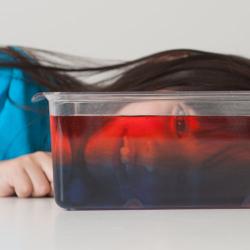Source Institutions
Source Institutions
Add to list Go to activity
Activity link broken? See if it's at the internet archive

In some parts of the world, lakes freeze during winter. In this activity learners will explore water’s unique properties of freezing and melting, and how these relate to density and temperature. Learners will use food coloring to investigate how hot, cold, and frozen water mix in this model. Step-by-step instructions are included with photos and safety recommendations. Activity guide includes a "What's going on?" explanation and relevant connections to the density of water and how organisms survive in a frozen lake.
- 10 to 30 minutes
- 10 to 30 minutes
- $5 - $10 per group of students
- Ages 8 - adult
- Activity, Model
- English
Quick Guide
Materials List (per group of students)
- Loaf pan-sized container, glass or clear plastic
- Blue and red food coloring
- Hot and cold water
- Two drinking cups of equal size (approximately 250 – 500 mL (1-2 c)) that can hold hot and cold water
- 12 blue ice cubes (made in advance using blue food coloring)
- Container for holding and pouring water (such as a pitcher)
- Spoon
Subjects
-
Earth and Space Science
-
Earth Processes
- Weather and Climate
-
Earth Structure
- Oceans and Water
- Biosphere
-
Earth, Moon and Sun
- Seasons
-
Earth Processes
-
Life Sciences
-
Ecology
- Ecosystems
-
Ecology
-
Physical Sciences
-
States of Matter
- Solids
- Liquids
- Changes of Phase
-
States of Matter
Audience
To use this activity, learners need to:
- see
- see color
Learning styles supported:
- Involves hands-on or lab activities
Other
This resource is part of:
Access Rights:
- Free access
By:
Source Collection
- DIY Science Apps
Rights:
- , The Regents of the University of California, 2015
Funding Source:
- National Science Foundation, DRL1114663
